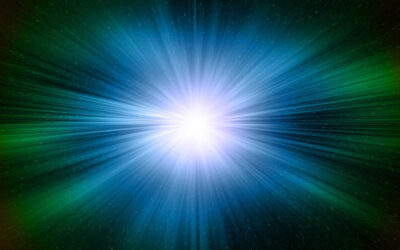A team of scientists has developed a new type of material that efficiently emits circularly polarized light — waves with a rotating electric and magnetic fields — thanks to a specially designed molecule with a built-in handedness, or chirality.
This breakthrough has the potential to transform optical technologies and open new avenues in fields such as spintronics, which is a futuristic form of computing that stores and processes information using the rotational states of electrons.
“This is a real breakthrough in making a chiral semiconductor,” said Bert Meijer from the Eindhoven University of Technology and one of the lead authors of the study, in a press release. “By carefully designing the molecular structure, we’ve coupled the chirality of the structure to the motion of the electrons and that’s never been done at this level before.”
The advantages of chiral materials
Chirality is a property of a molecule that makes it different from its mirror image, much like how a left hand differs from a right hand. Most molecules are not chiral, meaning they can be superimposed onto their mirror images. However, some, including many organic compounds found in living organisms, have a specific handedness that affects their interactions. For example, DNA has a right-handed helical structure, and many biological molecules only function properly in one chiral form.
In addition to their crucial role in biology, chiral molecules exhibit unique optical behavior. Because of their handedness, they interact with light in a special way. When they emit light, they naturally produce circularly polarized waves, where the electric and magnetic fields rotate as the light moves forward, much like a corkscrew. This is different from the more familiar linearly polarized light, where the fields vibrate in a straight, fixed direction.
Circularly polarized light has wide-ranging applications. It can improve the performance of liquid crystal displays by reducing glare and unwanted reflections, help scientists analyze material structures more effectively, and enhance emerging computing technologies.
In spintronics, for instance, circularly polarized light can selectively excite electrons based on their spin, a crucial step toward developing ultra-fast, energy-efficient computers.
However, implementing these applications in practice has proven difficult. Many existing chiral light-emitting materials suffer from either low efficiency — meaning they emit far fewer photons than they absorb — or poor polarization purity. This refers to how well a material emits predominantly one type of circular polarization over the other. In most cases, left- and right-handed photons are produced in nearly equal amounts, with the imbalance often being less than 1%, making it difficult to achieve the desired control over polarization.
Organic semiconductors provide a solution
To address these challenges, the researchers used organic semiconductors — carbon-based materials that can conduct electricity better than insulators but not as well as metals. Insulators, like rubber or glass, do not allow electricity to flow because their electrons are tightly bound to their atoms. Metals, on the other hand, conduct electricity very efficiently because they have free-moving electrons that can easily carry an electric charge. Semiconductors fall in between, with some electrons able to move under the right conditions, making them useful in electronics.
In semiconductors, electrons exist in different energy levels or bands. These bands are separated by a gap called the “bandgap.” The size of the bandgap determines how easily electrons can move between the bands and thus affects the material’s ability to conduct electricity. A smaller bandgap allows for easier electron movement, making the material a better conductor, while a larger bandgap makes it a poorer conductor, like in insulators. The bandgap also influences the material’s optical properties, determining how it absorbs and emits light.
The two most important bands are the valence band, where electrons are bound to atoms, and the conduction band, where electrons are free to move and carry electrical current. When the semiconductor absorbs radiation, photons with energy equal to or greater than the bandgap can excite electrons from the valence band to the conduction band, allowing precise control over their motion. This process, in turn, influences the properties of the emitted light, making semiconductors valuable for applications in optoelectronics.
“When I started working with organic semiconductors, many people doubted their potential, but now they dominate display technology,” said Professor Sir Richard Friend from Cambridge’s Cavendish Laboratory, who co-led the research.
The team focused on a complex organic molecule called dimethyloctyltriazatruxene . When these molecules are embedded in a semiconductor host material, they self-assemble into larger, chiral structures known as supramolecules. Because the molecules are chiral, the interaction between nuclei and electrons translates this chirality into electron motion, which results in the emission of circularly polarized light.
The researchers confirmed that this chiral arrangement directly affects how electrons behave in the material, leading to a distinct handedness in the emitted light.
“Unlike rigid inorganic semiconductors, molecular materials offer incredible flexibility — allowing us to design entirely new structures, like chiral light-emitting diodes,” said Friend. “It’s like working with a Lego set with every kind of shape you can imagine, rather than just rectangular bricks.”
A step toward practical applications
Experiments with thin films of these molecular structures showed remarkable results. The dissymmetry factor, which measures the degree of circular polarization, exceeded 10% — a significant improvement over previous materials. Even more impressively, the quantum efficiency of light emission reached 16%, meaning that the material emits a substantial fraction of the photons it absorbs.
“When excited by blue or ultraviolet light, self-assembled dimethyloctyltriazatruxene emits bright green light with strong circular polarization — an effect that has been difficult to achieve in semiconductors until now,” said Marco Preuss from Eindhoven University of Technology. “The structure of this molecule allows electrons to move efficiently while affecting how light is emitted.”
The researchers believe this discovery will quickly find practical applications, given how efficiently the material produces circularly polarized light.
“We’ve essentially reworked the standard recipe for making organic light emitting diodes, like those found in smartphones, allowing us to trap a chiral structure within a stable, non-crystallizing matrix,” said co-first author Rituparno Chowdhury from Cambridge’s Cavendish Laboratory. “This provides a practical way to create circularly polarized light-emitting diodes, something that has long eluded the field.”
Reference: Rituparno Chowdhury et al, Circularly polarized electroluminescence from chiral supramolecular semiconductor thin films, Science (2025). DOI: 10.1126/science.adt3011
Feature image credit: geralt on Pixabay

















